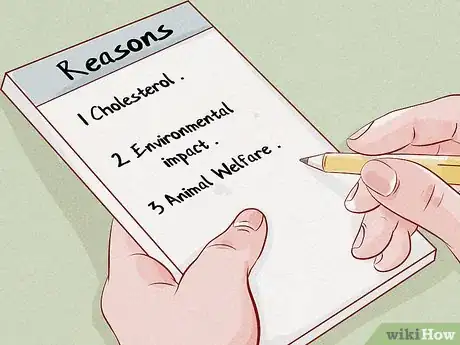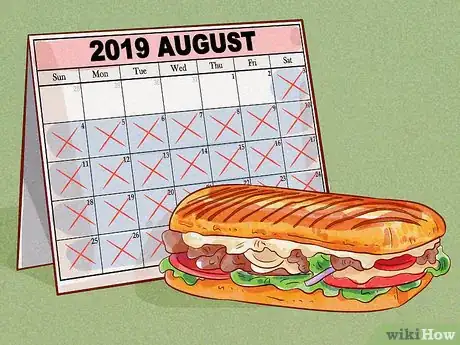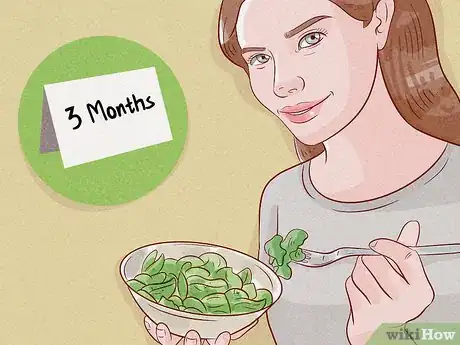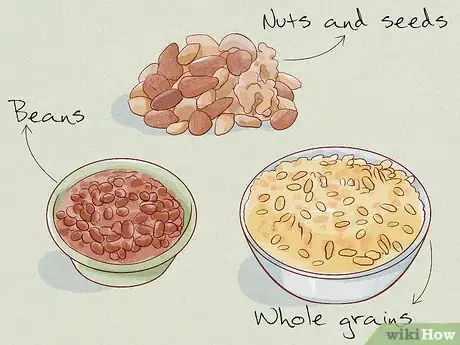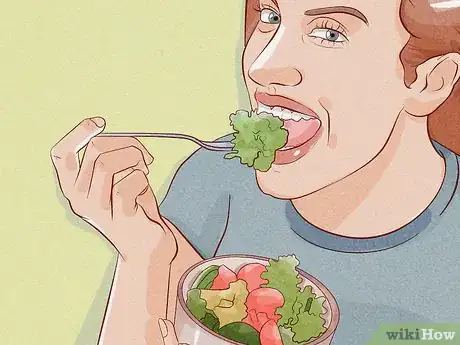This article was co-authored by Tara Coleman and by wikiHow staff writer, Jessica Gibson. Tara Coleman is a Clinical Nutritionist who has a private practice in San Diego, California. With over 15 years of experience, Tara specializes in sports nutrition, body confidence, and immune system health and offers personalized nutrition, corporate wellness, and online learning courses. She received a BS in Biology from James Madison University and spent six years in the pharmaceutical industry as an analytical chemist before founding her practice. Tara has been featured on NBC, CBS, Fox, ESPN, and Dr. Oz The Good Life as well as in Forbes, Cosmopolitan, Self, and Runner’s World.
There are 14 references cited in this article, which can be found at the bottom of the page.
This article has been viewed 124,818 times.
The decision to stop eating meat is a very personal one. You might be concerned about animal welfare, environmental impacts, or your own health. Regardless of your reason for giving up meat, you'll be more likely to stick with it if you create achievable goals, replace the meat with nutritious food, and find a diet that works for you. Remember that giving up meat will take some adjustment, so don't stop trying if you relapse or crave meat.
Steps
Setting Yourself up for Success
-
1List the reasons you want to stop eating meat. You might have a vague idea of why you don't want to eat meat anymore or you may have specific reasons. Take a few minutes to write down all the reasons you have for not eating meat. You can refer to this list later if you're struggling and it can remind you why not eating meat is important to you. Examples of reasons could include:[1]
- Lowering your cholesterol or reducing inflammation
- Reducing your environmental impact
- Improving animal welfare
-
2Make small, achievable goals towards giving up meat.[2] If giving up meat is your ultimate goal, think of all the smaller steps you need to take to get there. Write down goals or barriers that you'll have to get past and celebrate when you achieve them. This can give you momentum for reaching your goal.[3]
- For example, you might challenge yourself to give up eating fast food within 1 week or cutting back the number of meals with meat to 3 times a week.
- Some gradual goals could be cutting out red meat within 2 weeks, not eating chicken within 3 weeks, and not eating pork by 1 month.
- Make some of your goals fun. You could challenge yourself to try 2 new vegetarian ingredients or cuisine each week, for instance.
Advertisement -
3Set a deadline for when you want your diet to be meat-free. As you set your goals, continue to make them more challenging so you can reach your goal of not eating meat. It can help to have a deadline in mind so you know you're working towards a specific end.[4]
- You might tell yourself that you want your diet to be meat-free within 3 months. Your goals can gradually work meat out of your diet by then.
-
4Create a plan to deal with cravings. You may find yourself missing meat or at least thinking about it more. Instead of giving in, try to think of an alternative way to satisfy your craving. You might be craving meat because you want a specific flavor, so try these common swaps:[5]
- If you're craving a filling, butter flavor, eat avocado instead of meat.
- Make a peanut butter sandwich instead of chicken if you're craving protein.
- Eat mushrooms, miso, or parmesan cheese if you're craving a savory umami flavor.
-
5Don't give up if you relapse and eat meat. You don't have to stop eating meat completely. Even eating less meat than you used to can have positive impacts. Giving up meat can be difficult, especially if you've grown up eating it at every meal. Remind yourself that you can work towards your next goal and you'll eventually be able to stop eating meat altogether.
Tip: Consider telling friends and family that you're going to stop eating meat. They may be a support network that you can turn to if you continue to struggle.
Gradually Eating Less Meat
-
1Make meal plans for a few days or a week. Don't wait until you're really hungry to decide what you want to eat or order. Instead, plan nutritious plant-based meals so you don't have an excuse to just grab a meat-based meal. Set aside a few hours to make a list of the meals you plan to make during the week and the ingredients you'll need.[6]
- If you have time, you could also prep some of the ingredients. Chopping produce ahead of time can make it easier to get a vegetarian meal on the table.
- It's also a good idea to plan some savory snacks since these can curb your cravings for meat. For example, keep smoked nuts, roasted chickpeas, or vegetable chips in the pantry.
-
2Use a little meat as a flavor instead of the main dish. If you eliminate meat from your diet, you might experience cravings. To reduce cravings, try eating meat as a supporting ingredient instead of making it the focus of a meal. For example, buy a package of bacon and cook just a few slices to crumble into pasta with roasted vegetables.[7]
- For example, instead of cooking lasagna with ground beef, make a vegetable lasagna but include a few slices of chopped prosciutto to give it a little meaty flavor.[8]
-
3Add new vegetarian ingredients or cuisines to your diet. It's easy to focus on missing meat, but you can distract yourself and your tastebuds by trying new flavors. For example, instead of eating rice a few times a week, make quinoa or farro.[9]
- Swap out your standard meat and potatoes meal for a vegetable and noodle dish, such as veggie udon.
-
4Try meat substitutes as you cut meat out of your diet. If you really miss the flavor and texture of meat, buy a meat substitute. There are more high-quality meat substitutes than ever, so try a few to see what you like. You can find patties, crumbles or links made from textured vegetable protein, tempeh, or seitan.[10]
- Don't forget to check the freezer section of your grocery store for some of these meat substitutes.
-
5Add plant-based protein sources to your diet[11] . If you're used to getting most of your protein from meat, you'll need to ensure that you're still getting it in the foods you eat. To get a variety of nutrients, eat different plant-based proteins throughout the day. Try eating:[12]
- Nuts and seeds
- Beans
- Lentils
- Whole grains
Tip: Try making one of your ground beef recipes, such as meat sauce or chili, with black beans instead.
Trying a New Diet
-
1Talk with your doctor about your nutritional needs. It's always a good idea to consult with your doctor about your diet, especially if you're trying to become a vegetarian to improve your health. Your doctor might recommend that you take supplements that contain:[13]
- Vitamin B-12
- Omega-3 fatty acids
- Iron
- Vitamin D
Tip: If you plan on becoming a vegan, you'll need to supplement or eat foods fortified with vitamin B-12. If you're still going to eat eggs and milk, you probably don't need to supplement.
-
2Try a flexitarian diet if you want to occasionally eat meat or fish. Some people find that they miss eating meat or want to reintroduce it to their diet. Decide if you'd like to start eating meat again in much smaller amounts. If you'd like to eat meat a few times a week, the flexitarian diet might be the best choice for you.[14]
- Remember that you're not stuck in any one diet. You might transition from a meat-based diet to a flexitarian diet before cutting out meat altogether.
-
3Determine what type of vegetarian diet you want to follow. Once you no longer eat meat, you need to decide if you'll eat animal products. Some lacto-vegetarians eat dairy, such as milk and cheese, but not eggs while ovo-vegetarians eat eggs but not dairy. Just decide which animal products you'll eat and which ones you'll avoid.[15]
- Lacto-ovo-vegetarians don't eat meat, but they do eat dairy and eggs.
Tip: The label for your diet isn't the most important thing. The point is for you to decide what you're comfortable with eating.
-
4Eat a pescatarian diet if you want to include fish. If you live somewhere with easy access to seafood, you might want to keep this protein source in your diet while cutting out red meat, poultry, and pork. Realize that you don't have to eat seafood every day to follow a pescatarian diet. You'll still need to include lots of plant-based protein sources, fruits, and vegetables.[16]
- Aim for a variety of seafood throughout the week so you're getting lots of nutrients.
-
5Consider a vegan diet if you don't want to eat any animal products. If you've been a vegetarian for a while and are eating a nutritious diet, you might decide to stop eating all animal products, such as eggs, dairy, and honey. Research which foods to cut from your diet so you can make the switch.[17]
- Keep in mind that some food products aren't vegan even though they don't have meat in them. For example, powdered sugar isn't vegan because it's processed with bone char.
- Some vegans also choose to give up animal products of any kind, including clothing and home goods, such as leather belts or chairs.
Expert Q&A
Did you know you can get expert answers for this article?
Unlock expert answers by supporting wikiHow
-
QuestionIs it healthy to stop eating meat?
 Tara ColemanTara Coleman is a Clinical Nutritionist who has a private practice in San Diego, California. With over 15 years of experience, Tara specializes in sports nutrition, body confidence, and immune system health and offers personalized nutrition, corporate wellness, and online learning courses. She received a BS in Biology from James Madison University and spent six years in the pharmaceutical industry as an analytical chemist before founding her practice. Tara has been featured on NBC, CBS, Fox, ESPN, and Dr. Oz The Good Life as well as in Forbes, Cosmopolitan, Self, and Runner’s World.
Tara ColemanTara Coleman is a Clinical Nutritionist who has a private practice in San Diego, California. With over 15 years of experience, Tara specializes in sports nutrition, body confidence, and immune system health and offers personalized nutrition, corporate wellness, and online learning courses. She received a BS in Biology from James Madison University and spent six years in the pharmaceutical industry as an analytical chemist before founding her practice. Tara has been featured on NBC, CBS, Fox, ESPN, and Dr. Oz The Good Life as well as in Forbes, Cosmopolitan, Self, and Runner’s World.
Clinical Nutritionist
References
- ↑ https://www.health.com/health/article/0,,20410549,00.html
- ↑ Tara Coleman. Clinical Nutritionist. Expert Interview. 22 October 2020.
- ↑ https://www.uofmhealth.org/health-library/zx3211
- ↑ https://www.webmd.com/fitness-exercise/guide/smart-weight-loss-fitness-device
- ↑ https://www.meatlessmonday.com/articles/5-unexpected-foods-satisfy-meat-cravings/
- ↑ https://www.thekitchn.com/the-beginners-guide-to-meal-planning-what-to-know-how-to-succeed-and-what-to-skip-242413
- ↑ https://iheartvegetables.com/tiny-tweaks-eat-less-meat/
- ↑ https://www.allrecipes.com/recipe/11786/hearty-vegetable-lasagna/
- ↑ https://iheartvegetables.com/tiny-tweaks-eat-less-meat/
- ↑ https://www.insider.com/best-vegan-meat-substitutes-2018-6
- ↑ Tara Coleman. Clinical Nutritionist. Expert Interview. 22 October 2020.
- ↑ Tara Coleman. Clinical Nutritionist. Expert Interview. 22 October 2020.
- ↑ https://www.mayoclinic.org/healthy-lifestyle/nutrition-and-healthy-eating/in-depth/vegetarian-diet/art-20046446
- ↑ https://www.webmd.com/diet/a-z/flexitarian_diet
- ↑ https://www.mayoclinic.org/healthy-lifestyle/nutrition-and-healthy-eating/in-depth/vegetarian-diet/art-20046446
- ↑ https://www.thekitchn.com/pescatarian-diet-267524
- ↑ https://www.forbes.com/sites/nomanazish/2018/11/30/how-to-smoothly-transition-to-a-plant-based-diet/#7c37693b50dc
- ↑ Tara Coleman. Clinical Nutritionist. Expert Interview. 22 October 2020.
- https://www.mayoclinic.org/healthy-lifestyle/nutrition-and-healthy-eating/in-depth/meatless-meals/art-20048193
